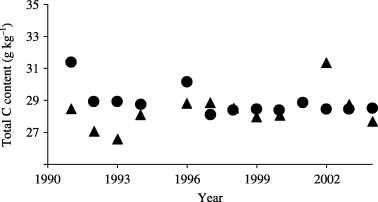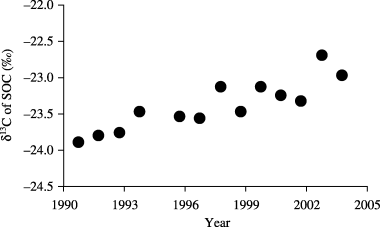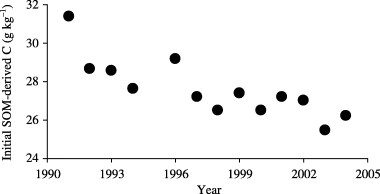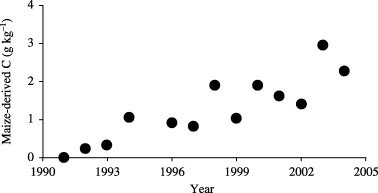Abstract
Northeast China is the main production area of maize and soybean in China. In the present study, the rates of decomposition and replacement of soil organic carbon (SOC) were estimated using the soil inventory collected since 1991 from long-term maize and soybean cultivation plots in Heilongjiang Province, Northeast China, to evaluate the sustainability of the present cultivation system. The total carbon (C) content in soil was stable without any significant changes in the plots (approximately 28.5 g C kg−1). The δ13C value of soil organic matter under continuous maize cultivation increased linearly with an annual increment of 0.07 from −23.9 in 1991, which indicated that approximately 13% of the initial SOC was decomposed during the 13-year period of maize cultivation, with a half-life of 65 years. Slow decomposition of SOC was considered to result from the low annual mean temperature (1.5°C) and long freezing period (170–180 days year−1) in the study area. In contrast, the amount of organic C derived from maize increased in the soil with a very slow annual increment of 0.17 g C kg−1, probably because of the removal of all the plant residues from the plots. Based on the soil organic matter dynamics observed in the study plots, intentional recycling/maintenance of plant residues was proposed as a way of increasing soil fertility in maize or soybean cultivation.
INTRODUCTION
Maize (Zea mays L.), soybean (Glycine max Merr.) and rice (Oryza sativa L.) are major staple crops in China. The area cultivated with maize in China covered 1.4, 2.0 and 2.4 × 107 ha in 1960, 1980 and 2003, respectively, whereas soybean continuously covered approximately 9.3 × 106 ha during this period (http://zzys.agri.gov.cn/nongqing/nongqing.asp). Thus, although the increase in the cultivated area from 1960 to 2003 was only 1.7-fold for maize and negligible for soybean, the production of maize and soybean increased drastically during this period: 1.6 × 107 and 6.4 × 106 tons in 1960, 6.3 × 107 and 7.9 × 106 tons in 1980, and 1.2 × 108 and 1.5 × 107 tons in 2003 for maize and soybean, respectively (http://zzys.agri.gov.cn/nongqing/nongqing.asp).
Northeast China including Liaoning, Jiling, Heilongjiang and Neimenggu Provinces was the main production area of maize and soybean, and accounted for 35% and 39% in 1960, 27% and 42% in 1980 and 29% and 50% in 2003, respectively, of the total production area in China (http://zzys.agri.gov.cn/nongqing/nongqing.asp). These statistical records require that the soil fertility of Northeast China be carefully monitored under maize and soybean cultivation to enable stable and sustainable production in the future.
It is generally recognized that soil fertility, which is evaluated based on the organic matter content in soil, is decreasing in farmlands worldwide. Changes in soil fertility can be estimated from the balance between the annual input of plant residues to soil (e.g. crops, weeds, compost) and the decomposition rate of soil organic matter (SOM). Plant residues derived from C3 and C4 plants display δ13C values of −12 and −27, respectively (CitationBoutton et al. 1998; CitationDiels et al. 2001;Citation Smith and Epstein 1971), because of the difference in their photosynthetic mechanisms (CitationBender 1971; CitationSmith and Epstein 1971). Therefore, the annual input of SOM derived from C4 plants and the decomposition rate of the original SOM accumulated under C3 vegetation can be evaluated independently in farmlands where C3 plants were replaced with C4 plants.
The determination of the natural 13C abundance of SOM is a suitable method for evaluating the effect of land-use changes and field management on the decomposition and stabilization rates of soil organic carbon (SOC) (CitationBalesdent et al. 1990; CitationFlessa et al. 2000; CitationLudwig et al. 2003; CitationMcDonagh et al. 2001; CitationRömkens et al. 1999) and for quantifying the C turnover rates of SOC in several particle-size fractions (CitationBesnard et al. 1996; CitationGerzabek et al. 2001; CitationGleixner et al. 1999; CitationJolivet et al. 2003).
The SOC content was 30% and 45% lower in farmlands with continuous maize cultivation for 12 and 27 years, respectively, than in nearby forests in France, and 18% and 23% of the SOC was derived from maize residues (CitationJolivet et al. 2003). The SOC content decreased more drastically from 84–103 g C kg−1 to 38 g C kg−1 for 25–30 years after deforestation for maize cultivation in the sub-humid Ethiopian highlands, where 20–36% of SOC was derived from maize (CitationSolomon et al. 2002). Land-use change from grasslands to farmlands (maize) was less serious in terms of soil degradation, and no decrease in the SOC level was recognized in Canada and France (CitationBolinder et al. 1999;Citation Puget et al. 1995), where 9–21% and 45% of SOC were derived from maize residues after 15 and 23 years in the farmlands, respectively.
It is well known that field management influences the C turnover rate based on 13C analysis, and 3.70, 3.95 and 4.00 kg C m−2 of SOC that originated from grasses remained in soil after 17 years of maize cultivation under conventional, no-tillage and superficial tillage management, respectively (CitationBalesdent et al. 1990). In contrast, the effect of fertilization on the turnover rate of SOC was not recognized from 13C analysis after 32 years of maize cultivation in Canada (CitationGregorich et al. 1996).
Thus, although information about the rates of degradation and replacement of SOC is accumulating worldwide, information about the SOC dynamics in the farmlands of Northeast China, the major grain belt in China, is not available. The purpose of the present study was to estimate the rates of decomposition and replacement of SOC by using the soil inventory collected from a long-term maize cultivation plot in Heilongjiang Province, Northeast China, to estimate the sustainability of the present maize cultivation system.
MATERIALS AND METHODS
Soil samples and field history
We used air-dried soil samples that had been collected periodically from maize and soybean monoculture plots at Hailun Experimental Station for Agricultural Ecology, Northeast Institute of Geography and Agricultural Ecology, Chinese Academy of Sciences, Heilongjiang Province (47°26′N, 126°38′E, 240 m a.s.l.) since 1991. Urea and (NH4)2HPO4 amounting to 62 kg N ha−1 and 69 kg P2O5 ha−1 were applied to maize fields as basal fertilizer, and an additional 69 kg N ha−1 from urea was applied at the booting stage. For soybean, 27 kg N ha−1 and 69 kg P2O5 ha−1 from (NH4)2HPO4 were applied as basal fertilizers. Seeding and harvesting were carried out in early May and early October, respectively. The collection from 9 holes in each plot of the 0–10 cm soil layer, which were mixed to obtain a composite sample, was carried out in April or May except for 1994, 2001 (October) and 2004 (June). Although the cultivation history before 1991 was not fully documented, the δ13C value of the soil samples collected in 1991 (−23.89) indicated that C3 plants had been cultivated as major crops in the past.
The mean annual precipitation was 530 mm and the mean annual temperature was 1.5°C. The soil was a Black soil (Mollisol) derived from loamy loess. Particle-size distribution determined using the pipette method was as follows: 40% sand, 26% silt and 34% clay for the 0–20 cm soil layer. The mean grain yields (± annual deviation expressed as standard deviation) of maize and soybean, 5.7 ± 0.8 and 2.1 ± 0.4 ton ha−1, did not vary appreciably between 1991 and 2004, respectively.
The soil samples were passed through a 2 mm mesh screen and any plant residues were carefully discarded. All the sieved samples were further crushed to pass through a 0.5 mm mesh screen.
The above-ground parts of maize were collected in June 2004 from four replicates. The materials were oven-dried and pulverized using a vibration mill (TI-100, HEIKO, Japan).
Determination of total C content and δ13C values of soil samples
The presence of a significant amount of inorganic C in the soil samples was checked by the addition of 2 mol L−1 HCl under submerged conditions. Because the addition of the acid did not result in CO2 ebullition, the total C content and δ13C values of the soil samples were directly measured without any pretreatment (even if 100 discernible bubbles with a diameter of 1 mm evolved with the addition of HCl to a 1 g soil sample, the amount of inorganic C was 28 µg, which was approximately one thousandth of the total C content in the soil sample [approximately 28 mg C g−1 soil]). The total C content in soil and δ13C values of SOM (maize plot only) in plant samples were measured using a NC analyzer (Micro Corder JM1000CN, J. Science Laboratory, Kyoto, Japan) and a stable isotopic ratio mass spectrometer connected to an elemental analyzer (DELTA Plus–NC2500, ThermoFinnigan, San Jose, CA, USA), respectively.
Estimation of the proportion of SOC derived from maize C
The proportion of SOC derived from maize C (a; %) in the plot with continuous maize cultivation was estimated using the following equation:
RESULTS AND DISCUSSION
Total C content in soil samples and δ13C values of SOM
As shown in , the total C content in soil was stable without any appreciable changes under continuous maize (28.9 ± 0.9 g C kg−1) and soybean (28.3 ± 1.2 g C kg−1) cultivation. These findings are not in agreement with those obtained in a wheat–soybean rotation in farmers’ fields in the Heilongjiang Province by CitationLiu et al. (2003), in which the SOC content decreased by 15%, 25% and 48% compared with an uncultivated field (54.4 g C kg−1) after 5, 14 and 50 years of cultivation, respectively. The drastic decrease in SOC content in the field under the wheat–soybean rotation was attributed, in part, to the determination of SOC changes during the first 50 years
Figure 1 Total carbon (C) content in soil under continuous maize and soybean cultivation. (•), maize cultivation field; (▴), soybean cultivation field.

The δ13C values of SOM under continuous maize cultivation had increased linearly since 1991 (), and the increase in the δ13C value was best fitted to the following equation:
in which t is the year (AD) of measurement.
Estimation of temporal decrease in the initial SOC pool and accumulation rate of maize-derived C in soil
The carbon remaining after partial mineralization may differ in terms of the δ13C value from the initial carbon, with generally 13C enrichment, because isotopic discrimination against the heavier 13C isotope during microorganism-mediated respiration and decomposition can enrich the remaining organic matter with 13C (CitationAgren et al. 1996). CitationNatelhoffer and Fry (1988) showed in a laboratory experiment that because of overall isotopic fractionation during litter decomposition, the residual SOC was enriched with 13C, although they did not observe changes in the 13C content of SOC during the humification process. In contrast, it was reported in another study that organic matter from both wheat and maize underwent decomposition without significant 13C enrichment (CitationBalesdent et al. 1990). In the following data analyses and discussion we assumed that there would
Figure 2 Changes in the δ13C value of soil organic carbon (SOC) under continuous maize cultivation. δ13C () = 0.07 × (y − 1990) − 23.93 (significant at 1% level; y, the year of measurement).

Figure 3 Changes in the content of carbon (C) derived from initial soil organic matter (SOM) under continuous maize cultivation.

Figure 4 Changes in the content of carbon (C) derived from maize residues under continuous maize cultivation.

Temporal decrease in the initial SOC pool of the previous vegetation () and temporal increase in the SOC pool derived from maize () since 1991 were determined based on variations in the total C content and the proportion of maize-derived C estimated using Eq. Equation1. The average δ13C values of the initial SOM and maize plants were −23.89 (standard deviation 0.01) and −12.50 (standard deviation 0.28). Judging from the pattern of decrease in the initial SOC pool with time (t), a simple exponential model (C t = A0 × e −kt ) was used (CitationJolivet et al. 1997):
The equation indicated that only approximately 13% of the initial SOC was decomposed during the 13-year period of maize cultivation in the study field. The half-life (thl) and turnover rate (ttr) of the initial SOC expressed as 0.693/k and 1/k, respectively, were 65 (thl) and 94 (ttr) years.
The amount of organic C derived from maize (Cm) increased with the duration of cultivation as shown in . Again a simple exponential model [Cm = Am × (1 − e −kt )] was used to estimate the Cm chronosequence (CitationJolivet et al. 1997):
It was deduced from Eqs Equation3, Equation4 that half of the SOC in the field would be derived from maize residues (Cinitial SOC = Cmaize) in approximately AD 2077 under the present field management.
Half-life of the initial SOC and accumulation rate of maize-derivd C in soil
shows a comparison of the decrease in the SOC content and the half-life of the initial SOC determined in the present study using data reported in the literature under continuous maize cultivation. As in many studies soil samples were not available at the time of the onset of the experiment (CitationGregorich et al. 1996; CitationJolivet et al. 2003; CitationMcDonagh et al. 2001; CitationSolomon et al. 2002), reference soil samples that were located near the experimental plots were assumed to show the same C contents and δ13C values as those of the original soils in the literature. Thus, systematic soil collection was found to be indispensable for evaluating the changes in soil fertility associated with agricultural activities. The half-life of SOC at the present study site was longer than that recorded at sites described by other researchers (ranging from 15 to 33 years). Exceptions included the sites in Germany (CitationFlessa et al. 2000; CitationLudwig et al. 2003) and Tanzania (CitationMcDonagh et al. 2001), where the half-life was longer than that in our study, ranging from 97 to 152 years. Because the SOC content at those sites was low (6.7–13.1 g C kg−1), SOC at the onset of the experiment might consist mainly of recalcitrant organic C remaining after readily and slowly decomposable C was consumed by soil microorganisms. Although the Ethiopian and French soil samples (27.2–38.2 g C kg−1) contained similar amounts of SOC to that of the present soil samples, SOC half-life was very short, 15–18 years. The longer half-life of SOC at the present study site, notwithstanding the large SOC content (approximately 30 g C kg−1), probably resulted from the long freezing period of soil (170–180 days year−1) and low annual temperature (1.5°C), as well as the lower annual rainfall (530 mm).
Although all the maize residues were removed from the plot fields every year for cattle feeding, the SOC content had remained nearly constant since 1997 (). The annual decreasing rate of initial SOC [(A0 − A0 × e −k) / A0 × 100] was estimated from Eq. Equation3 to be approximately 1.1%, corresponding to 0.31 (= 29.6 – 29.6e −0.0106) g C kg−1 or approximately 310 kg C ha−1 (in the case where the bulk density = 1 and plow layer = 10 cm). In contrast, the accumulation rate of C derived from maize (most probably from maize roots) was 0.17 [= 33.1 × (1 − e −0.0052)] g C kg−1 year−1, based
Table 1 Comparison of the decrease in soil organic carbon (SOC) content and half-life of the initial SOC after maize cultivation
ACKNOWLEDGMENTS
We thank Mr Noriyuki Ikai, Nagoya University, for his technical assistance in the determination of the total C content. This research was conducted under the support of the Nakajima Foundation and the Chinese Academy of Sciences (Innovation Project; grant number KZCX1-SW-19-2).
REFERENCES
- Boutton , TW , Archer , SR , Midwood , AJ , Zitzer , SF and Bol , R . 1998 . δ13C values of soil organic carbon and their use in documenting vegetation change in a subtropical savanna ecosystem . Geoderma , 82 : 5 – 41 .
- Diels , J , Vanlauwe , B , Sanginga , N , Coolen , E and Merckx , R . 2001 . Temporal variations in plant δ13C values and implications for using the 13C technique in long-term soil organic matter studies . Soil BiolBiochem , 33 : 1245 – 1251 .
- Smith , BN and Epstein , S . 1971 . Two categories of 13C/12C ratios for higher plants . Plant Physiol , 47 : 380 – 384 .
- Bender , MM . 1971 . Variations in the 13C/12C ratios of plants in relation to the pathway of photosynthetic carbon dioxide fixation . Phytochemistry , 10 : 1239 – 1244 .
- Balesdent , J , Matiotti , A and Boisgontier , D . 1990 . Effect of tillage on soil organic carbon mineralization estimated from 13C abundance in maize fields . JSoil Sci , 41 : 587 – 596 .
- Flessa , H , Ludwig , B , Heil , B and Merbach , W . 2000 . The origin of soil organic C, dissolved organic C and respiration in a long-term maize experiment in Halle, Germany, determined by 13C natural abundance . JPlant NutrSoil Sci , 163 : 157 – 163 .
- Ludwig , B , John , B , Ellerbrock , R , Kaiser , M and Flessa , H . 2003 . Stabilization of carbon from maize in a sandy soil in a long-term experiment . EurJSoil Sci , 54 : 117 – 126 .
- McDonagh , JF , Birch Thomsen , T and Magid , J . 2001 . Soil organic matter decline and compositional change associated with cereal cropping in southern Tanzania . Land DegradDevelop , 12 : 13 – 26 .
- Römkens , PFAM , van der Plicht , J and Hassink , J . 1999 . Soil organic matter dynamics after the conversion of arable land to pasture . BiolFertilSoils , 28 : 277 – 284 .
- Besnard , E , Chenu , C , Balesdent , J , Puget , P and Arrouays , D . 1996 . Fate of particulate organic matter in soil aggregates during cultivation . EurJSoil Sci , 47 : 495 – 503 .
- Gerzabek , MH , Haberhauer , G and Kirchmann , H . 2001 . Soil organic matter pools and carbon-13 natural abundances in particle-size fractions of a long-term agricultural field experiment receiving organic amendments . Soil SciSocAmJ , 65 : 352 – 358 .
- Gleixner , G , Bol , R and Balesdent , J . 1999 . Insight to differential turnover and preservation of organic compounds in arable soils . Rapid CommMass Spectrom , 13 : 1278 – 1283 .
- Jolivet , C , Arrouays , D , Lévèque , J , Andreux , F and Chenu , C . 2003 . Organic carbon dynamics in soil particle-size separates of sandy Spodosols when forest is cleared for maize cropping . EurJSoil Sci , 54 : 257 – 268 .
- Solomon , D , Fritzsche , F , Lehmann , J , Tekalign , M and Zech , W . 2002 . Soil organic matter dynamics in the subhumid agroecosystems of the Ethiopian highlands: Evidence from natural 13C abundance and particle-size fractionation . Soil SciSocAmJ , 66 : 969 – 978 .
- Bolinder , MA , Angers , DA , Giroux , M and Leverdière , MR . 1999 . Estimating C inputs retained as soil organic matter from corn (Zea maysL.) . Plant Soil , 215 : 85 – 91 .
- Puget , P , Chenu , C and Balesdent , J . 1995 . Total young organic matter distribution in aggregates of silty cultivated soil . EurJSoil Sci , 46 : 449 – 459 .
- Gregorich , EG , Ellert , BH , Drury , CF and Liang , BC . 1996 . Fertilization effects in soil organic matter turnover and corn residue C storage . Soil SciSocAmJ , 60 : 472 – 476 .
- Liu , X , Han , X , Song , C , Herbert , SJ and Xing , B . 2003 . Soil organic carbon dynamics in black soils in China under different agricultural management systems . CommunSoil SciPlant Anal , 34 : 973 – 984 .
- Agren , GI , Bosatta , E and Balesdent , J . 1996 . Isotope discrimination during decomposition of organic matter: a theoretical analysis . Soil SciSocAmJ , 60 : 1121 – 1126 .
- Natelhoffer , KJ and Fry , B . 1988 . Controls on natural nitrogen-15 and carbon-13 abundances in forest soil organic matter . Soil SciSocAmJ , 52 : 1633 – 1640 .
- Jolivet , C , Arrouays , D , Andreux , F and Lévèque , J . 1997 . Soil organic carbon dynamics in cleared temperate forest spodosols converted to maize cropping . Plant Soil , 191 : 225 – 231 .